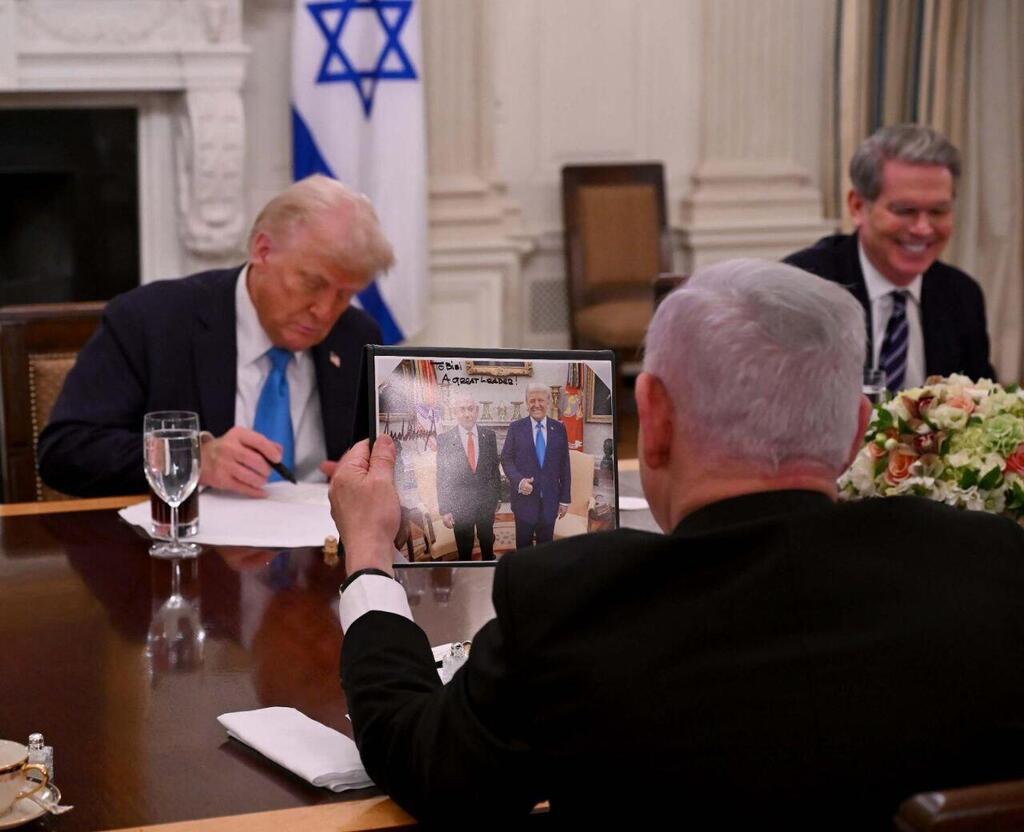When Prime Minister Benjamin Netanyahu stated in a government meeting this week that he and U.S. President Donald Trump share a coordinated and joint strategy, he was describing a reality. The current U.S. president and Israeli prime minister indeed operate according to a shared strategic approach. The essence of this approach can be summarized as follows: introduce a grandiose idea or take a dramatic action, then pause to allow all relevant parties to respond.
Observations are made regarding the reaction of the opposing side, public opinion at home, responses from the international and regional arenas and alternative proposals from mediators. Decisions are then taken intuitively—essentially "playing it by ear"—until some form of lasting arrangement is established. The result may not necessarily represent the ultimate aspirations of either Trump or Netanyahu, but it will be something they and their political allies can live with.
The primary weakness of this approach lies in its lack of clearly defined, realistic and achievable long-term goals. Consequently, it often fails to serve critical national security or other essential national interests. Instead, it tends to prioritize the personal interests of Trump, Netanyahu, or both. Another significant drawback is the inherently slow pace of this strategy, which wastes valuable time and exacts a heavy toll in human lives, suffering for captives and harm to both Israeli soldiers and uninvolved Gazans. Additionally, it requires an inordinate amount of resources.
Despite these flaws, the strategy does have two notable advantages. First, it is inherently proactive, often catching opponents and their supporters off guard, forcing them to concede to some of the demands made by those initiating the process. Second, it grants decision-makers considerable flexibility. Most options remain available to them. They can fully implement the original idea, abandon it altogether, or significantly modify it without being bound to predetermined, measurable outcomes.
This flexibility allows Trump and Netanyahu to maneuver according to their priorities and interests, while always presenting the outcome as a success—essentially "drawing the bullseye" wherever the "arrow" happens to land, regardless of whether it achieves the original goal, such as maximizing the return of captives or ensuring long-term national security improvements.
A shared approach
It is no coincidence that Trump and Netanyahu employ a similar strategy. Both are driven by narcissism and hubris, exhibiting overconfidence in their ability to identify and exploit opportunities as they arise while neutralizing obstacles and risks in negotiations. Both leaders believe they can act with a small circle of trusted advisors, operating in a freewheeling, unscripted manner without adhering to a structured plan and deliberately keeping their goals ambiguous.
Trump and Netanyahu meet in the White House
(Video: White House)
or Trump, this strategy often manifests as a lack of "follow-through." When asked by journalists whether Egypt and Jordan would agree to absorb hundreds of thousands of Palestinians evacuated from Gaza as part of a reconstruction plan he proposed, Trump’s response was a noncommittal, "We'll see." This echoes his first term as president, when he similarly brushed off questions about securing an agreement for North Korea’s denuclearization. Those efforts ultimately ended in failure, with Trump returning empty-handed and embarrassed after his high-profile summits with Kim Jong-un.
Netanyahu, on the other hand, is more experienced in dealing with a hostile and challenging media environment. He is also more cautious than Trump, largely due to the fragility of his coalition, with figures such as Smotrich and Ben Gvir closely watching his every move. As a result, Netanyahu speaks in vague terms like "total victory" but avoids clarifying what that means or outlining his plans for "the day after."
Get the Ynetnews app on your smartphone: Google Play: https://bit.ly/4eJ37pE | Apple App Store: https://bit.ly/3ZL7iNv
He allows this "day after" to take shape, as tank commanders say, "on the move." Months ago, when IDF achieved most of its defined objectives through maneuvering, Israel could have negotiated a deal to release captives, stripping the Islamist organization of its control over the transportation and distribution of humanitarian aid—its lifeline for survival and recovery. However, consistent with the "we'll see" strategy, Netanyahu refrained from setting clear goals. Instead, he stalled, leaving everyone guessing about his intentions while engaging in endless, secret negotiations with the UAE and Egypt, producing no practical results, all the while waiting for Trump’s re-election.
A calculated gamble
In the matter of the captives, Netanyahu’s decision to wait for Trump proved to be a successful gamble. Trump managed to tip the scales in favor of the current deal and will likely see it through in subsequent stages. Trump may also succeed in advancing a positive resolution regarding Gaza’s "day after." His plan to "cleanse Gaza of Gazans" has alarmed the Arab world. While the likelihood of this plan being fully implemented is slim, it has already pressured Arab states to formulate an alternative to Hamas rule in Gaza.
 Ron Ben-YishaiPhoto: Yair Sagi
Ron Ben-YishaiPhoto: Yair SagiThis would enable Israel and the U.S. to agree on Gaza’s reconstruction, funded by Saudi Arabia, the UAE and Qatar. Based on what is currently known about this framework, it does not yet meet Netanyahu’s minimum requirements and certainly does not align with the aspirations of the nationalist-right wing of his coalition. However, it provides Netanyahu with room to maneuver—and perhaps manipulate—while flattering Trump to achieve his goals.
However, the opposite outcome is also possible, highlighting a significant flaw in this strategy. There is no guarantee that any agreement for Gaza’s "day after" brokered by Trump, based on proposals from Egypt, Saudi Arabia, the UAE and Jordan, will adequately address Israel’s existential security needs or enhance the safety of communities in the Negev.
Should such a deal fail to meet these standards, Netanyahu will face a difficult dilemma: either resume military operations, defying Trump, or explain to his coalition partners, the Israeli public and residents of the Gaza border region that he had no choice but to accept the framework supported by the U.S. President. In doing so, he would hope for their understanding and acceptance of the compromise.





